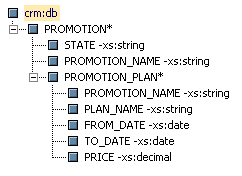







|
XML namespaces are a mechanism that ensures that there are no name conflicts (or ambiguity) when combining XML documents or referencing an XML element. BEA AquaLogic Data Services Platform fully supports XML namespaces and includes namespaces in the queries generated in WebLogic Workshop.
This section includes the following topics:
Namespaces provide a mechanism to uniquely distinguish names used in XML documents. XML namespaces appear in queries as a namespace string followed by a colon. The W3C uses specific namespace prefixes to identity W3C XQuery data types and functions. In addition, BEA has defined the fn-bea: namespace to uniquely identify BEA-supplied functions and data types.
Table 4-1 lists the predefined XQuery namespaces used in AquaLogic Data Services Platform queries.
For example, the xs:integer data type uses the XML namespace xs. Actually, xs is an alias (called a prefix) for the namespace URI.
XML namespaces ensure that names do not collide when combining data from heterogeneous XML documents. As an example, consider a document related to automobile manufacturers that contains the element <tires>. A similar document related to bicycle tire manufacturers could also contain a <tires> element. Combining these documents would be problematic under most circumstances. XML namespaces easily avoid these types of name collisions by referring to the elements as <automobile:tires> and <bicycle:tires>.
XML schema namespaces—including the target namespace—are declared in the schema tag. The following is an example using a schema created during metadata import:
<xsd:schema targetNamespace="http://temp.openuri.org/SampleApp/CustOrder.xsd" xmlns="http://www.w3.org/2001/XMLSchema" xmlns:xsd="http://www.w3.org/2001/XMLSchema"
xmlns:bea="http://www.bea.com/public/schemas"
elementFormDefault="unqualified" attributeFormDefault="unqualified">...
The second line declares the target namespace using the targetNamespace attribute. It this case, the target namespace is bound to the namespace declared on the fourth line, meaning that all element and attribute names declared in this document belong to:
http://www.bea.com/public/schemasThe third line of the schema contains the default namespace, which is the namespace of all the elements that do not have an explicit prefix in the schema.
For example, if you see the following element in a schema document:
<element name="appliance"type="string"/>
the element element belongs to the default namespace, as do unprefixed types such as string.
The fifth line of the schema contains a namespace declaration (bea) which is simply an association of a URI with a prefix. There can be any number of these declarations in a schema.
References to types declared in this schema document must be prefixed, as illustrated by the following example:
<complexType name="AddressType">
<sequence>
<element name="street_address" type="string"/>
...
</sequence>
</complexType>
<element name="address" type="bea:AddressType"/>
It is recommended that you create schemas with elementFormDefault="unqualified" and attributeFormDefault="unqualified". This enables you to rename a namespace by renaming a single complex element, instead of having to explicitly map every element.
AquaLogic Data Services Platform (AquaLogic Data Services Platform) automatically generates the namespace declarations when generating a query. Liquid Data employs a simple scheme using labels ns0, ns1, ns2, and so forth. Although it is easy to change assigned namespace names, care must be taken to make sure that all uses of that particular namespace are changed.
When a return type is created, by default it is qualified, meaning that the namespace of complex elements appear in the schema.

If you want simple elements or attributes to appear as qualified, you need to use an editor outside WebLogic Workshop to modify the generated schema for either or both attributeFormDefault and elementFormDefault to be set to qualified.


|